Aristotelia serrata (Makomako, Wineberry)
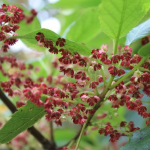
Aristotelia serrata, commonly called Makomako or Wineberry, is a fast-growing, small deciduous tree. Attractive rose-coloured flowers in spring. Deep red to black berries in summer are highly sought after by native birds. Good shade tree in sheltered areas. Frost-tender when young, however hardy once mature.
It has serrated, green leaves which may develop a purple hue, and typically grows to 5 m tall and 4 m wide. Wineberry is commonly used as a smaller specimen tree, trimmed into a hedge, or used for screening and shelter.
Best results with this tree are achieved when it is planted in full sun on a well-drained site. It will tolerate cool climates and moderate frost once established, as well as most soil conditions but only short periods of dry.
Habitat: Lowland to montane forests. Often forming dense thickets following disturbance.
Flowering: Spring [September - December]
Fruiting: Summer [November - February]
FoodSource for: Birds(F,S,N,O), Bees, Insects, Lizards
My Lists: Pioneer Species
Astelia fragrans (Kakaha, Bush Lily)
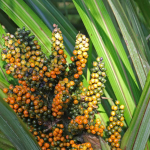 Sold Out
Sold Out
Astelia fragrans, commonly known as bush lily, bush flax or kakaha, is the most common astelia species found in New Zealand. It grows from sea level to elevations of approximately 900 metres. It has attractive broad green flax-like leaves, stiffly arched and the ribs are often reddish. It has scented flowers in Spring. When the berries mature over summer, they turn orange. Lizards feed on the berries and use the foliage to hide, making any Astelia a good addition if you want to attract lizards to your garden. Best in sheltered semi-shade.
Habitat: Kakaha occupies a range of semi-shaded, moist sheltered sites. It can be found on forest floors, cliffs, rock bluffs, lakeshore scarps and stream margins, as well as in swamps.
Flowering: Spring [October - January]
Fruiting: Summer - Autumn [January - May]
FoodSource for: Birds(F,N), Insects, Lizards
Astelia grandis (Kakaha, Swamp Astelia)
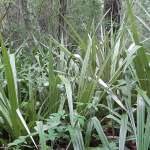 Sold Out
Sold Out
Astelia grandis, or Kakaha, is the largest of our Astelias, growing to 2m much like Harakeke. It has very broad olive green leaves with a silvery sheen beneath and reddish-purple midribs. The leaves are more erect and less tapered than A.fragrans. Forms clumps to 2m. The Female has orange berries. As a result, the female plant is a good lizard and bird attractor. These sweet juicy berries are edible even when raw.
It is an understory plant in lowland swamp forests or Kahikatea forests, but it is found mostly in the warmer areas of the South Island. Dioecious, meaning male and female plants must be grown if seed is required
Habitata: Kakaha occupies a range of moist sites. It can be found on forest floors, cliffs, rock bluffs, lakeshore scarps and stream margins, as well as in swamps. Best in sheltered semi-shade.
Flowering: Spring [September - October]
Fruiting: Summer [December - February]
Astelia nervosa (Kakaha, Mountain Astelia)
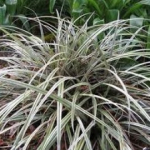 Sold Out
Sold Out
Astelia nervosa, commonly known as Mountain Astelia, is a distinctive evergreen perennial plant that is native to New Zealand. It belongs to the Asteliaceae family and is known for its striking foliage and unique form, making it a popular choice for ornamental gardens and landscapes.
The leaves of Astelia nervosa are the main feature of this plant. They are long, narrow, and sword-shaped, with a silvery-blue or grey-green color. The leaves are arranged in a clumping, basal rosette form, and can grow up to 90 centimeters in length, creating a dramatic and architectural presence in the garden.
The foliage of Astelia nervosa is typically stiff and leathery, with serrated edges, and may have a slight twist or curl, adding to its unique appearance. The silver-blue or grey-green color of the leaves provides a striking contrast against other plants in the garden and can create a bold focal point or add texture and interest to mixed plantings.
Astelia nervosa produces inconspicuous flowers that are held on tall, slender stalks that rise above the foliage. The flowers are typically small, brownish or greenish in color, and are followed by small, fleshy fruit.
Astelia nervosa is a hardy plant that is well-adapted to a range of growing conditions, although it prefers well-drained soils and partial shade to full sun. It is tolerant of coastal conditions, making it suitable for coastal gardens, and is also known to be deer-resistant.
In landscaping, Astelia nervosa is often used for its striking foliage and unique form. It can be used as a specimen plant, in mixed plantings, or in containers to create a bold and dramatic focal point. It is also well-suited for modern or contemporary gardens, as well as tropical or exotic-themed gardens.
Habitat: Found on mountainsides in forests and damp grasslands in the montane to the sub-alpine zone.
Flowering: Summer [January - February]
Fruiting: Autumn [February - May]
My Lists: Pioneer Species
Austroderia richardii (Toetoe)
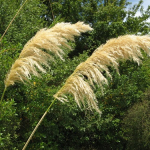
Austroderia richardii, commonly known as toetoe, is a large perennial tussock grass species that is native to New Zealand. It belongs to the family Poaceae and is endemic to the country, meaning it is found nowhere else in the world.
Austroderia richardii has distinctive features that make it easily recognizable as its one of the tallest grass species in New Zealand. The leaves are long and narrow, with a rough texture, and can grow up to 1.5 meters in length. The leaf margins are often serrated or toothed, giving them a slightly serrated appearance.
Austroderia richardii is typically found in wetland habitats, such as swamps, bogs, and riverbanks, although it can also occur in other types of habitats, including coastal dunes and forest clearings. It is an important plant for wetland ecosystems, providing habitat and food for a variety of birds, insects, and other wildlife.
Toetoe has been used by Māori, the indigenous people of New Zealand, for various purposes. The leaves have been used for weaving, thatching, and as bedding material, while the flower heads have been used for decorative purposes. Today, Austroderia richardii is also cultivated as an ornamental grass in gardens and landscaping due to its impressive size and striking appearance.
Overall, Austroderia richardii, or toetoe, is a prominent grass species in New Zealand, known for its tall stature, feathery flower heads, and importance in wetland ecosystems and cultural uses. A very tough, hardy and fast growing withstanding strong winds, costal conditions, drought and cold conditions.
On farm, Austroderia richardii is a good wind break once established as they grow in clumps and are very hardy plants that can withstand many weather conditions. Protects stock and stays below pivot irrigation, also useful in runoff prevention and along water courses. Toe toe is an attractive bank stabilisation plant, good for a range of soils and suits riparian plantings.
Habitat: Abundant, from the coast to subalpine areas. Common along stream banks, river beds, around lake margins, and in other wet places. Also found in sand dunes.
Flowering: Spring [September - November]
Fruiting: Summer [October - March]
My Lists: DrainField, Erosion Control, Wetland, Pioneer Species
Carex buchananii (Buchanan)
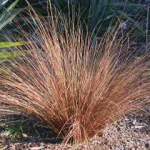
Carex buchananii is a 60 cm tall native hair sedge which forms upright clumps of very fine, hair-like leaves of a bronzy-cinnamon colour. The stiff blades curve at the end. Looks fabulous planted in large drifts. Hardy to just about any conditions but happiest in a sunny position that does not dry out completely in summer. Evergreen. Hardy.
Habitat: Coastal to montane (up to 1000 m a.s.l.). On beaches, lagoon, lake and stream margins, or in damp ground within open forest or short tussock grassland.
Flowering: Spring [October - December]
Fruiting: Summer - Autumn [November - June]
My Lists: Pioneer Species
Carex dipsacea (Teasel Sedge)
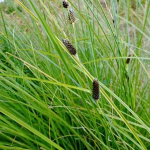
Carex dipsacea, commonly called Teasel Sedge, is an attractive coarse green grass with narrow foliage that can develop strong bronze tones. Summer seed-heads of dark brown. Will grow happily in moist damp conditions in sun or shade. Hardy to both wind and frost. Tough and robust, great for mass planting in difficult spots. Carex dipsacea is an important plant species for wildlife, as it provides habitat and food for various insects and birds. It is also used in horticulture for its ornamental value, as it adds texture and form to garden settings. Evergreen. Hardy.
Habitat: Coastal to subalpine. Favouring wetlands this species usually grows along rivers, lakes and ponds within sand dunes, tall forest, shrubland, and tussock grassland.
Flowering: Spring [October - December]
Fruiting: Summer [December - February]
Carex secta (Pukio, Swamp Sedge)
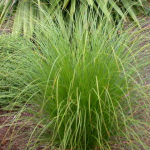
Carex secta, commonly called Swamp Sedge or Pukio, is a well known species and it is a most useful plant for use in re-establishing or enhancing wetland areas. Common to swampy areas and in standing water and it is a most useful plant for use in enhancing wetlands and ponds. Older plants in moist to wet sites, often form thick trunk-like bases 1 metre tall from its own tightly matted roots. It takes on a yellow-green colour in open situations with the colour being intensified in the Winter. Attractive dark brown seed heads in summer. Great for bank stabilisation and riparian planting.
Endemic to New Zealand, found throughout the country. Carex secta is riparian species. It is often found in plant communities that include but are not limited to Apodasmia similis, Carex maorica, Carex virgata, Phormium tenax, and Eleocharis acuta.
Habitat: Widespread in suitable wetlands from coastal to montane wetlands.
Flowering: Summer [October - January]
Fruiting: Autumn [October - March]
My Lists: DrainField, Erosion Control, Wetland, Pioneer Species
Carex virgata (Pukio, Swamp Sedge)
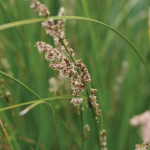 Sold Out
Sold Out
Carex virgata, commonly called Swamp Sedge or Pukio, is a vigorous sedge suitable for swamps, drain margins, seepages and wet pastures. A successful colonising plant, used for wetland planting and revegetation. Suitable for conditions which may vary periodically from very wet to very dry. More dry tolerant and shorter than C. secta. Evergreen. Hardy.
It pairs well with Carex secta (also called Pukio) for bank stabilisation. As it handles being in a swampy area, it is ideal for lower bank planting in riparian revegetation projects. It is also useful in water treatment projects as it minimises nutrient runoff. This makes it ideal for planting streamside on farms.
Carex virgata is widespread in open, swampy conditions and also in damp sites within lowland forest. In parts of the country this sedge is often the dominant carice of lowland alluvial forest. Found in communities that include but are not limited to Apodasmia similis, Carex maorica, Carex secta, Phormium tenax, and Eleocharis acuta.
Habitat: Widespread from sea level to about 1000 m a.s.l. in open, swampy conditions and also in damp sites within lowland forest. In parts of the country this sedge is often the dominant carice of lowland alluvial forest.
Flowering: Spring [October - December]
Fruiting: Summer [December - May]
My Lists: DrainField, Wetland
Carmichaelia australis (Makaka, Common Broom)
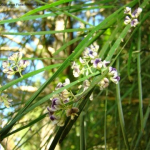
Carmichaelia australis, commonly called Common Broom or Makaka, is a small to large shrub with spreading erect and flattened to round photosynthetic stems. Meaning that instead of leaves the stems are flattened to catch the sunlight. It is a hardy fast growing upright broom. From spring through to summer, it has small 5-6 mm white flowers with purple veins and sometimes has purple centres. The seeds are yellow, orange or red often with black dots. The seeds are distributed when the seedpod bursts so the seed travels only short distances, compared to wind and bird-dispersed seed. Attractive to bees. Evergreen. Prefers full sun and tolerates dry, windy and cold sites. Hardy.
Habitat: Coastal to montane, on river terraces, stream banks, colluvium, rock outcrops, talus and fan toe slopes, among tussock grassland and grey scrub, on the edge and margins of dense bush, forest, and in swamps.
Flowering: Spring - Summer [October - February]
Fruiting: Summer - Autumn [November - May]
Cassinia vauvilliersii (Mountain Tauhinu, Cottonwood)
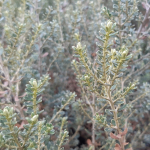
Cassinia vauvilliersii, commonly called Mountain Tauhinu or Cottonwood, is a bushy shrub with small silver green leaves with fine silver hair beneath. The stems silver/white in colour. It has an attractive silver-grey appearance and flowers in profusion with clusters of tiny cream daisy (wheel-shaped) flowers followed by down-covered seed heads.
Habitat: Lowland to montane or lower subalpine shrubland and grassland.
Flowering: Summer [December - March]
Fruiting: Autumn [March - April]
Chionochloa flavescens (Broad-leaved Snow Tussock)
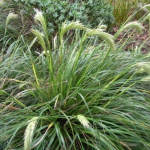
Chionochloa flavescens, commonly known as Snow Grass or Haumata, is grown for its foliage, golden tassels, and hardiness. It grows as a clump to about 1.5 m high and the same wide bearing narrow, green leaves with a graceful arch. Chionochloa flavescens is a hardy grass that is commonly planted alongside water, mass planted under trees, or individually in rock gardens, or used to line a walkway or driveway. Smaller than the South Island Toetoe Austroderia richardii plus handles drier conditions.
Habitat:
Flowering: Summer [December - February]
Fruiting:
My Lists: Pioneer Species
Chionochloa rubra (Red Tussock)
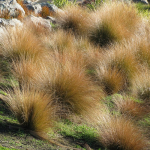
Chionochloa rubra, commonly known as Red Tussock grass, is a species of tussock that is native to New Zealand. It is a perennial grass that belongs to the Poaceae family and is known for its distinctive appearance and ecological importance.
Chionochloa rubra forms large, dense tussocks that can reach heights of up to 1.5 meters tall, although some specimens can grow taller in favorable conditions. The leaves are long, narrow, and stiff, with leaf edges are often rolled inward, giving them a tubular appearance. The tussocks are often reddish-brown at the base, which gives the species its common name "red tussock."
Chionochloa rubra plays a vital ecological role in New Zealand's ecosystems. The dense tussocks provide shelter and nesting sites for native birds. The tussocks also help prevent erosion by stabilizing soil with their extensive root systems, and they can trap and store snow, which helps regulate water flow in alpine catchments. Additionally, Chionochloa rubra is an important food source for native insects and other herbivores, and it contributes to nutrient cycling in the ecosystem.
Red tussock is a most adaptable vegetation which will grow in the exposed and windy environment. It can tolerate low-nutritious, and also can grow in relatively wet or dry soil conditions. It is harsh enough to use one individual specimen plant however, if space allowed, would be better for planted several as a group. Red tussock is a useful vegetation for helping to reestablish wildlife habitat, especially useful as a buffer plant around wetland areas.
Habitat: Subalpine to alpine (rarely upper montane). Often the dominant of tussock grassland, also found within shallow bogs or fringing the margins of deeper bogs and small ponds, tarns and slow flowing streams. Occasionally in canopy gaps in upper montane forest or within subalpine scrub.
Flowering: Spring [October - December]
Fruiting: Summer [November - May]
My Lists: DrainField, Erosion Control, Pioneer Species
Clematis paniculata (Puawananga)
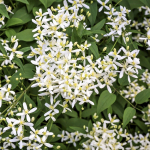 Sold Out
Sold Out
Clematis paniculata, or Puawananga, is an attractive climber with masses of white flowers in spring. The plant does best when planted in a moist but well-drained soil with roots in a cool shady place and the foliage is going to be in the sun.
Clematis paniculata is a vigorous grower and can reach a height of up to 20 feet (6 meters) or more, depending on the growing conditions. It prefers a sunny to partially shaded location and in well-drained, fertile soil. It is a versatile plant that can be grown on trellises, arbors, fences, or allowed to scramble over shrubs and trees. It is relatively low-maintenance, requiring regular watering and pruning to promote healthy growth and abundant flowering.
Habitat: Coastal to montane in shrubland or tall forest (up to 1000 m a.s.l.).
Flowering: Winter - Summer [July - October]
Fruiting: Summer [November - January]
Coprosma areolata (Thin Leaved Coprosma)
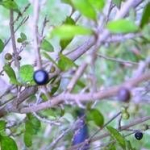
Coprosma areolata grows as a divaricating shrub or small tree to 3m, usually erect in habit. The pale green leaves are small and thin, hence the common name Thin Leaved Coprosma. It produces blue or black berries which the birds can eat. Grows in wet, lowland forest and can also grow in exposed places.
Habitat: Lowland to lower montane forest.
Flowering: Spring [October - December]
Fruiting: Summer [January - March]
Coprosma crassifolia (Mingimingi)
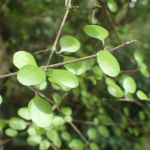
Coprosma crassifolia, commonly called mingimingi, is a stiffly-branched upright shrub with small dark-green leaves and white to pale-yellow berries that attract skinks and birds. It's a tough shelter and revegetation shrub for drought-prone sites. The upright, columnar habit is good for narrow spaces.
In the forest, the shrub is sparsely branched but in the open, it forms densely branched thickets. The stiff, more or less round remote leaves and the stiff, red-brown branchlets distinguish C. crassifolia from all other Coprosma species. The flowers are unisexual. The berries flesh is transparent but look white due to the white seed within. They may also look pale yellow.
Habitat: Coastal rocky and sandy lowland to lower montane shrubland and forest, up to 600 m.
Flowering: Spring [September - October]
Fruiting: Summer - Autumn [November - June]
Coprosma linariifolia (Mikimiki, Yellow Wood)
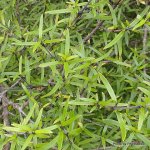 Sold Out
Sold Out
Coprosma linariifolia, commonly called mikimiki or yellow wood, is a shrub or small tree that is native to New Zealand. It has small narrow leaves and yellow wood (under the bark).
Habitat: Coprosma linariifolia is found in lowland to montane forest and scrub from the central North Island to the bottom of the South Island. Hardy
Flowering: Summer [December - February]
Fruiting: Autumn [January - April]
Coprosma lucida (Shining Karamu)
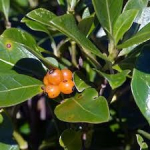
Coprosma lucida is endemic and commonly known as shining karamu. It is a small tree that is ideal for coastal projects. It can survive in many climates, but is most commonly found in coastal areas, lowland forests, or shrublands. It performs best where it can derive sufficient moisture and some shade, although it is tolerant of challenging locations such as coastal shrubland. Its wide, bright green leaves are thick, smooth, and shiny.
As with other Coprosma species, their berries are ideal for attracting birds, especially bellbirds, tuis and waxeye.
Habitat: Coastal and lowland forests or shrublands.
Flowering: Spring [August - December]
Fruiting: Summer [January - June]
Coprosma propinqua (Mingimingi)
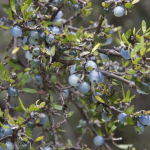
Coprosma propinqua, commonly known as Mingimingi, is a species of evergreen shrub or small tree that is native to New Zealand. It belongs to the family Rubiaceae and is known for its distinctive foliage and attractive appearance.
Coprosma propinqua exhibits a compact and bushy growth habit, typically reaching a height of 1 to 3 meters. The leaves are opposite, simple, and small, measuring about 1 to 3 centimeters in length. The leaves are elliptical or lanceolate in shape, with smooth margins, and are usually glossy and dark green in color. Some varieties may have variegated leaves with contrasting colors, such as yellow or cream markings.
The flowers of Coprosma propinqua are small and inconspicuous, typically greenish or yellowish in color. They are borne in clusters and are not particularly showy. The plant is dioecious, which means that male and female flowers are borne on separate plants.
The fruit of Coprosma propinqua is a fleshy drupe, typically spherical or ovoid in shape, and about 5 to 7 millimeters in diameter. The fruit initially appears green, but matures to a dark purple or black color when ripe. The fruit is often eaten by birds, which help to disperse the seeds.
Coprosma propinqua is commonly found in various habitats in New Zealand, including forests, shrublands, and coastal areas. It is known for its ability to tolerate a wide range of growing conditions, including poor soils and exposure to salt spray, making it a hardy and adaptable plant. It is also known to have medicinal properties and has been used traditionally by Maori for various purposes.
In cultivation, Coprosma propinqua is often used as an ornamental plant in gardens and landscapes due to its attractive foliage and low maintenance requirements. It can be grown as a standalone specimen plant, or used as a hedge or ground cover. It is typically propagated by seeds or cuttings, and prefers well-drained soils and a sunny to partly shaded location.
Habitat: Found in lowland forest, along forest margins and streambanks, in scrub, gravelly places and along the edges of bogs and swamps.
Flowering: Spring [October - December]
Fruiting: Autumn [January - April]
My Lists: DrainField, Wetland, Pioneer Species
Coprosma rhamnoides (Red-fruited Coprosma)
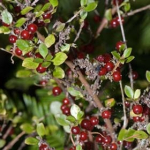
Coprosma rhamnoides is a dense tightly divaricating shrub. Tiny light green leaves. Stiff red/brown branches. Good for exposed, dry areas. N.Z. flora has a large number of shrubs with small tough leaves and wiry interlacing branches – divaricates. Some even have brown or grey new growth, giving a dead-like unattractive appearance. It is suggested that this may be a defensive growth mechanism to deter visits from browsing moa. Coprosma rhamnoides is a good example.
In October the plants develop small pale cream flowers which are dioecious (sexes separate). These flowers are wind pollinated. Drupes appear on the female plant in March-April small (3-4mm) red berries, turning dark red or black as they ripen.
Habitat: It is widespread in Canterbury and Westland in lowland to lower montane-scrubland and forest mostly as an understorey plant. It is less common higher in the montane zone.
Flowering: Spring [October - November]
Fruiting: Autumn [March - April]
Coprosma robusta (Karamu)
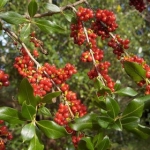
Coprosma robusta, Karamu, is a fast-growing shelter, hedging and nurse plant. Competes well with gorse. Laden with bright-orange fruit/seeds March-July. As with other Coprosma species, their berries are ideal for attracting birds, especially bellbirds, tuis and waxeye. This is one of the many reasons why Coprosma robusta is a pioneer revegetation species. Its wide, bright green leaves are thick, smooth, and shiny. Can be confused with C. lucida. Shade tolerant. Suits low-frost sites. Evergreen.
History of use: Karamū is used for a variety of purposes in human culture. The fruit that Coprosma robusta produces can be eaten, and the shoots of Karamū are sometimes used for medical purposes.
Habitat: Common throughout coastal, lowland and lower montane habitats within shrublands and open sites within forest.
Flowering: Spring [August - November]
Fruiting: Autumn [March - August]
My Lists: Erosion Control, Pioneer Species
Coprosma rotundifolia (Round-leaved Coprosma)
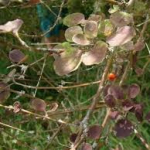
Coprosma rotundifolia is an attractive upright shrub with soft, thin, quite rounded pale-green and purple-blotched leaves with interlaced branches. Rather slender shrub up to 2-4 m tall; branches spreading to divaricate that does well in dappled light. Coprosma rotundifolia is superficially similar to and most often confused with C. rubra. Coprosma rubra differs from the much more widespread C. rotunidfolia by its smaller leaves. Leaves are covered in small hairs, rapidly tapering to a sharp tip. Both species may be found growing together. The flowers and orange-red berries are in small clusters. Should be planted in a free draining but moist fertile soil.
The flowers are dioecious (male and female flowers are on separate trees). The female flowers are seated in the green calyculus which is formed by the fusion of two stipulate bracts. The petals above are joined with the 2 female translucent stigmas rising above. They are pollinated by wind. Coprosma rotundifolia produces orange or red fruit (4-5 mm in diameter) on very short stalks. The fleshy fruits have two seeds and are dispersed by birds.
Habitat: Lowland to montane. Usually in riparian forest and shrubland, especially on alluvial soils or those derived from calcareous parent materials.
Flowering: Spring [September - November]
Fruiting: Summer - Winter [September - August]
Coprosma rubra
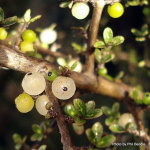
Coprosma rubra is a rare hardy shrub with stems of young branches a reddish colour. Yellow / White berries. Well-drained sites.
Small-leaved Coprosmas are good for revegetation projects, hedging, and adding texture into a garden. They are evergreen and suited to full sun to part shade. They produce berries from January to April that are dispersed by fruit-eating animals (frugivory). They also provide habitat for New Zealand’s declining lizard and gecko populations.
Mingimingi provides a tough shelter, providing good food for native birds and lizards, as well as ground cover.
Habitat: Lowland to montane. Usually in riparian forest and shrubland, especially on alluvial soils or those derived from calcareous parent materials.
Flowering: Spring - Summer [September - January]
Fruiting: Summer - Autumn [January - April]
Coprosma rugosa (Needle-leaved Mountain Coprosma)
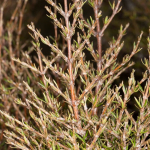
Coprosma rugosa is a hardy native shrub good for exposed sites. A divaricating shrub selected for its texture and structure. Excellent for mass planting, hedged or low maintenance, structure plantings. Evergreen. Hardy.
Habitat: Found in lowland, montane and subalpine grasslands, scrublands and forest margins.
Flowering: Spring [October - November]
Fruiting: Autumn [February - April]
Coprosma virescens (Mingimingi)
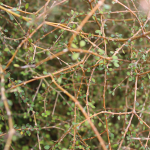
Coprosma virescens, mingimingi, is an upright shrub or small tree with attractive thin, pale-green leaves. Bark is mottled grey, pale-yellow and cream. The fruit are white or green-tinged, sometimes mottled with black. Thrives in cold conditions, partially deciduous putting the bold branch colour on show in winter.
Small-leaved coprosmas are good for revegetation projects, hedging, and adding texture to a garden. Mingimingi are evergreen and suited to full sun to part shade. They produce berries from January to April that are dispersed by fruit-eating animals (frugivory). They also provide habitat for New Zealand’s declining lizard and gecko populations. As attractors of these small animals, they are a pioneer shrub in revegetation projects. Mingimingi provides a tough shelter, providing good food for native birds and lizards, as well as ground cover for these.
Habitat: Lowland to lower montane. On well drained to poorly draining fertile soils (often overlying calcareous or base-rich igneous rocks). In forest and shrubland.
Flowering: Spring [September - November]
Fruiting: Summer [May - July]
My Lists: Pioneer Species
Cordyline australis (Ti Kouka, Cabbage Tree)
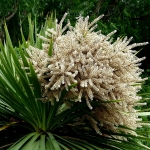
Cordyline australis, Ti Kouka, commonly called Cabbage Tree, is one of the most identifiable New Zealand native plants in the landscape. It has a tall straight trunk or trunks and a dense round head, with a sphere of long narrow leaves. Cabbage tree produces a profusion of attractive and scented flowers in spring. It is an abundant seeder. It looks most natural in the ornamental garden if planted in groups. Three or more plants can be planted together in the same hole to produce this effect. It grows in all soils and situations, even in swampy ground, where little else of interest will grow.
Cordyline australis is a light-demanding pioneer species, and seedlings die when overtopped by other trees. To grow well, young plants require open space so they are not shaded out by other vegetation. Its fruit and nectar are a favourite food source for kererū and tūī. Bellbirds like to nest in Tī Kōuka. Some lizards forage among the flowers of Cordyline australis and the nectar of the flowers is sought after by insects.
History of use: The Maoris obtained a most nutritious food, kauru, from the root of the young cabbage tree. This root is an extension of the trunk below the surface of the ground and is shaped like an enormous carrot some 2–3 ft long. An observer of the early 1840s, Edward Shortland, noted that the Maoris “prefer those grown in deep rich soil; they have learned to dig it at the season when it contains the greatest quantity of saccharine matter; that is, just before the flowering of the plant. They then bake, or rather steam it in their ovens. On cooling, the sugar is partially crystallised, and is found mixed with other matter between the fibres of the root, which are easily separated by tearing them asunder, and are then dipped in water and chewed”. The trunk of the cabbage tree is so fire-resistant that early European settlers used it to make chimneys for their huts. They also brewed beer from the root.
Medical Uses: An infusion of the leaves was used for dysentery and diarrhoea and for cuts. (From "Maori medical lore" by W. H. Goldie. 1905) The leaves were softened by rubbing and scraping. These scrapings were applied as an ointment to cuts, cracks in the skin and sores (from unpublished notes by Beryl Moore 1940). The younger inner shoots and the top of the stem were boiled and eaten by nursing mothers and were given to their children for colic. (From unpublished notes by T. Kururangi 1941)
Habitat: Widespread and common from coastal to montane forest. Most commonly encountered on alluvial terraces within riparian forest.
Flowering: Spring [October - December]
Fruiting: Summer - Autumn [January - April]
My Lists: Erosion Control, Wetland, Pioneer Species
Corokia cotoneaster (Korokio)
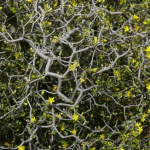
Corokia cotoneaster, or Korokio, is a good hedging and ornamental shrub. Corokia cotoneaster prefers to survive in areas that are not wet. It will grow and develop in dry, rocky, and dense soils. Attractive fine silver/grey foliage with bright yellow flowers in early summer. Densely interlaced branchlets. Red berries/seed. Evergreen. Very hardy to drought and cold.
As it is a tough plant that attracts birds and lizards, it is suitable for restoration projects. As part of the dry woodland community, it plays an important role in conditioning the soil. The soil conditioning creates a more hospitable environment for less robust species and broadleaf/podocarp forest succession. Other plants in this community include but are not limited to Discaria toumatou, Poa cita, Ozothamnus leptophyllus, Sophora prostrata, Melicytus alpinus and Cordyline australis.
Habitat: Found in scrub and on dry river flats and rocky places throughout the country.
Flowering: Spring [September - December]
Fruiting: Summer - Autumn [January - May]
Dacrycarpus dacrydioides (Kahikatea, White Pine)
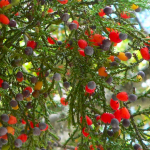
Dacrycarpus dacrydioides, commonly called kahikatea or white pine, is the tallest growing native tree, featuring handsome mature foliage and attractive buttressed roots. Best planted in moist to wet situations. The main tree species in Riccarton Bush. Edible fruit/seed from February to April is attractive to birds. On swampy sites Dacrycarpus dacrydioides develops buttresses for stability which extend to the roots. Not a garden tree. Ideal for revegetation planting, particularly in wetter areas and riparian projects. This native is frost-tolerant. Slow growing, loves fertile, swampy ground but can handle drier sites with good rainfall. Evergreen. Intolerant of heavy frosts.
Habitat: Lowland forest, formerly dominant on frequently flooded, and/or poorly drained alluvial soils. Occasionally extends into lower montane forest. Once the dominant tree of a distinct swamp forest type all but extinct in the North Island - the best examples remain on the West Coast of the South Island.
Flowering: Spring - Summer [October - January]
Fruiting: Autumn [February - April]
My Lists: Wetland
Dianella nigra (Turutu, NZ Blueberry)
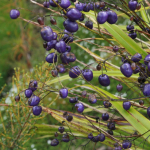 Sold Out
Sold Out
Dianella nigra, Turutu, has bright iridescent blue berries in summer, this small evergreen flax like plant works well in most situations and is especially attractive planted naturally in groups. Ideal for dry areas under existing vegetation. Turutu grows up to 50 cm tall and about 50 cm wide, making it a perfect smaller substitute for flaxes and does much better in semi shade than the unrelated mountain flax. The magnificent bright blue and fleshy berries that arise during summer from tiny white flowers with yellow stamens. The berries are spread and eaten by native birds.
Habitat: Coastal to montane (rarely subalpine) . Colonising a wide variety of habitats from open coastal headlands, gumland scrub and less frequently peat bogs through to dense forest and subalpine scrub.
Flowering: Spring [November - December]
Fruiting: Summer - Autumn [November - May]
Discaria toumatou (Matagouri)
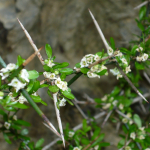
Discaria toumatou, commonly called Matagouri, is a tangle-branched, extremely thorny, divaricating shrub or small tree up to five metres tall. It has small leathery leaves close to the thorns, which are only abundant in spring or the shade. The flowers are tiny and white with no petals. It is the only New Zealand native plant that has thorns. Nitrogen-fixer. Common in dry shrublands of the eastern South Island.
It is most common in tussock grassland, stony areas and river beds. It is common in the eastern South Island, and found in a few coastal localities in the North Island south from the mouth of the Waikato River. As with other Discaria species it fixes nitrogen from the atmosphere with the help of symbiotic bacteria of the genus Frankia in its roots. It often grows in association with mingimingi (Coprosma propinqua), porcupine shrub (Melicytus alpinus, an alpine mahoe) and native brooms (Carmichaelia species). Seeds are dispersed by ballistic projection and water.
Matagouri plays an important ecological role in providing habitat and food sources for various native bird species, including silvereyes and bellbirds. The dense, spiny branches offer protection from predators and nesting sites for birds. Matagouri also helps stabilise the soil and prevent erosion in exposed and fragile environments.
As a native plant matagouri has complete protection on public conservation land and a degree of protection on private land under the Resource Management Act 1991. In a notable case a 400 ha area of matagouri forest, including trees that may have been 150 years old, was illegally sprayed at the head of Lake Sumner in 2001.
Habitat: Found in dry riverbeds, open rocky places and sand dunes from coastal to subalpine.
Flowering: Spring - Summer [October - January]
Fruiting: Summer [December - March]
Festuca novae zelandiae (Hard Tussock)
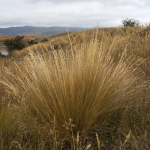
Festuca novae-zelandiae is a fine-leaved tawny tussock, upright in habit. A common component of low tussock grasslands on dry, windy and cold plains in Canterbury & Otago. It is deep rooted and dominant on steep, exposed slopes. In alpine areas at lower altitudes Festuca novae-zelandiae is associated with the narrow-leaved snow tussock (Chionochloa rigida). Stunning grass en masse. Needle thin erect leaves green to blonde. Tolerates poor soil and dry conditions.
The tawny leaves are 15-60cm long and have a width of 0.5-1mm. They are rough to touch and have sharply pointed tips. The margins are tightly in rolled giving the leaf a cylindrical appearance. The flowering stems are up to 70 cm tall with a 5-12 cm long open flowering panicle.
Habitat: Short tussock grasslands. Pre-1900s short tussock grassland covered considerable areas of the eastern South Island from sea level up to between 800 and 900 metres high.
Flowering: Spring [September - November]
Fruiting: Summer [December - February]
Fuchsia excorticata (Kotukutuku, Tree Fuchsia)
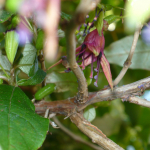 Sold Out
Sold Out
Fuchsia excorticata, also known as Kotukutuku, Tree Fuchsia, and New Zealand Fuchsia. Native to New Zealand and considered to be the worlds largest fuchsia. Attractive, small flowers begin to appear in mid spring. They are greenish-yellow then turn purple-red. followed by dark purple berries that are edible and tasting similar to tamarillo. It is easily recognised in its native environment by the characteristic appearance of its bark, which peels spontaneously, hanging in red papery strips to show a pale bark underneath. Plant in full sun or partial shade, hardy, semi-deciduous to deciduous.
Kōtukutuku is also a favoured food for bees. Other native trees that provide excellent food for honey bees and our own native bees (Leioproctus, Lasioglossum, and Hylaeus genera), are Psuedopanax arboreus, Cordyline australis, Schefflera digitata, Kunzea, and Pittosporum tenuifolium.
Habitat: Found in lowland and montane forests, especially along forest margins and streamsides where the soil is damp.
Flowering: Winter - Spring - Summer [July - January]
Fruiting: Summer [November - March]
My Lists: Winter Pollen
FoodSource for: Birds(F,S,N,O), Bees, Insects, Lizards
Fuscospora cliffortioides (Tewhai Rauriki, Mountain Beech)
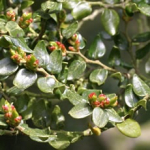
Fuscospora solandri var. cliffortioides is known as Mountain Beech because it is found at higher altitudes than Black Beech and can be found at various altitudes. It does not grow as tall as F. solandri and tolerates hard, dry infertile , poorly-drained sites in alpine areas. Differs from black beech by the finer leathery leaves with acute apices and obscure leaf venation. Although the two are closely allied and readily form hybrids, they are distinct species.
Habitat: Found in montane and subalpine forest and subalpine scrub. Often forming a dense, almost monospecific forest especially along the drier eastern side of the South Island.
Flowering: Summer [November - January]
Fruiting: Autumn [February - April]
Fuscospora fusca (Tawhai Raunui, Red Beech)
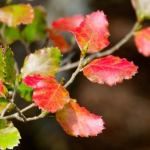
Fuscospora fusca, commonly called Red Beech, as a young tree has bright-red foliage during winter. Rapid early growth. Strong durable red wood. Can clip to a formal hedge. Suits a cool, moist, sheltered site with deep, well-drained soil. Evergreen.
Habitat: Found in lowland and montane forests.
Flowering: Spring [September - December]
Fruiting: Summer [November - March]
Fuscospora solandri (Tawhai Rauriki, Black Beech)
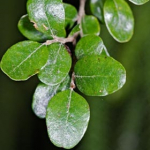
Fuscospora solandri, commonly called Black Beech, is a tall attractive tree with black bark and tough leathery leaves. Wind-hardier than other beeches. Suits moderately fertile, well-drained soils at low altitude in drier eastern areas. Evergreen.
At times Beech dominate the canopy, forming its own distinctive forest type. Often found in hardwood forest plant communities that include but are not limited to Aristotelia serrata, Pittosporum eugenioides, Pseudopanax arboreus, Podocarpus totara and Fuscospora cliffortioides among others. Differs from mountain beech by the oblong leaves with obtuse apices and obvious leaf venation. Although the two are closely allied and readily form hybrids, they are distinct species.
Known as black beech because it is prone to a sooty mould that covers the trunk and branches as a result of scale insect infestation. The insect secretes honeydew, feeding the mould and attracting birds and bees.
Habitat: Lowland to montane forest. At times the canopy dominant and forming its own distinctive forest type.
Flowering: Spring [September - December]
Fruiting: Summer [November - April]
Griselinia littoralis (Kapuka, Broadleaf)
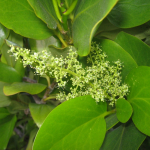
Griselinia littoralis, Kapuka or Broadleaf, is a very hardy evergreen tree. With regular trimming it makes a popular and effective hedging shrub. Grows in a range of soil types but prefers well-drained soil in full sun. Can tolerate frost and wind. It is useful in coastal situations (littoralis means shore growing) as it will tolerate frost, rough winds and salt spray. It is also a good upper bank plant for riparian plantings.
The oval leaves are leathery glossy and lush bright green. This plant produces small cream insignificant flowers that attract native pollinators. The tiny green and yellow flowers are also a good source of pollen for bees in the spring. In autumn the female trees have small purple-black fruit which tui eat.
History of use: It was an opening medicine and the inner bark was used on scrofula (a tuberculous infection of the skin on the neck). The timber was known for its durability.
Habitat: Found in lowland forests to subalpine scrub.
Flowering: Summer [November - January]
Fruiting: Autumn - Winter [February - August]
Haloragis erecta (Toatoa, Fire Weed)
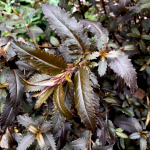
Haloragis erecta, Toatoa (not to be confused with other NZ plant species also known as toatoa) is a small perennial shrubby plant endemic to NZ, growing from sea level to about 500m altitude, distinctive for its toothed leaves and reddish stems. Toatoa readily colonises cleared or burnt ground, giving rise to another common name, fire weed.
Habitat: Coastal to montane in forest or scrub. Often on slip scars or colonising recently cleared ground. Often appearing following fire (hence one of the common names).
Flowering: [Throughout the year]
Fruiting: [Throughout the year]
My Lists: Pioneer Species
Hoheria angustifolia (Houhere, Narrow-leaved Lacebark)
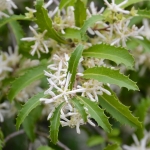
Hoheria angustifolia, Houhere, commonly known as Narrow-leaved Lacebark, is a tree native to New Zealand. It is a member of the family Malvaceae and is known for its striking appearance, with its slender leaves and attractive flowers. The leaves of Hoheria angustifolia are narrow and lanceolate.
The flowers of Hoheria angustifolia are one of its most distinctive features. They are typically large and showy, measuring 1.5-2 cm in diameter and arranged in clusters at the tips of the branches. The flowers are usually white and fragrant, and attract pollinators such as bees and butterflies.
The bark of Hoheria angustifolia is smooth and greyish-brown when young, becoming rougher and more fissured with age. The bark peels off in strips, revealing a lighter colored inner bark, which adds to its aesthetic appeal.
Hoheria angustifolia is primarily grown as an ornamental tree in gardens and parks, appreciated for its graceful form, attractive flowers, and interesting bark. It is also used in ecological restoration projects for its ability to attract pollinators and provide habitat for birds and insects.
History of use: The inner bark of Hoheria angustifolia has been used traditionally by Maori for making rope and twine.
Habitat: A common mostly lowland forest species frequenting alluvial forest where it may at times be dominant. Hoheria angustifolia is often an important host for taapia (Tupeia antarctica).
Flowering: Summer [December - March]
Fruiting: Autumn [February - April]
Kunzea ericoides (Kanuka)
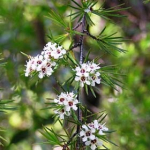
Kunzea ericoides, Kanuka tree, is a fast growing tree found throughout the north of the South Island. The leaves are softer to touch than Manuka and has smaller white flowers in Summer. It is very hardy, tolerating drought, frosts and poor soils. It is a primary colonising plant and used for revegetation as a nurse plant. Both manuka and kanuka are used as a nurse crop with other early colonizing plants for revegetation / restoration planting and are also very effective in erosion control. It is fast-growing, but short-lived, living up to 150 years. A juvenile takes about seven years to reach reproductive maturity. Very hardy.
History of use: The name "tea-tree" comes from the early bushman who used Manuka and Kanuka leaves to brew a drink similar to tea. Captain Cook was the first person to brew tea from manuka and said that it had a very agreeable, bitter taste when made with fresh leaves, but lost some of it piquancy when made with dry leaves. Kanuka leaves produce a tea that isn't quite as flavourful. Both tea-trees supposedly have medicinal uses and properties whose benefits far outweigh any considerations of taste. The leaves, brewed in water, help urinary complaints and reduced fevers.
The Maori and early settlers used to chew young shoots or swallow a drink made from seed capsules as a cure for dysentery and diarrhoea. The liquid from boiling the bark was used to treat constipation, as a sedative to promote sleep and reduce fever, for bathing sore eyes, treating colic, inflamed breasts, scalds and burns. The white gum was applied to scalds and burns and was taken by adults and children to relieve coughing. There are much more medicinal uses to which tea-tree was put to. Kanuka flowers produce a reasonable amount of nectar that is quite favoured by honeybees. The thick golden honey is hard to remove from honeycombs, but is quite popular for its strong taste and reputed antibacterial properties. Nowadays New Zealand’s monofloral Manuka and Kanuka pharmaceutical honey are both renowned for their natural health benefits.
The tough wood was used by Maori for implements such as fern root beater, mauls, paddles, weapons, spade blades, weeders, digging sticks and bird spears. The timber was noted for its straight grain, durability and strength by early European settlers, and was in demand for wheel-spokes, tool handles and other such purposes. Kanuka and Manuka wood is commonly used as firewood, especially for barbeques, or charred into charcoal. Older trees of have their trunks covered with a light brown bark that readily strips off, and is frequently used for fire-kindling. Both Manuka and Kanuka branches have been used to make brush brooms.
Habitat: Coastal to lowland shrubland, regenerating forest and forest margins, also present in montane forest, ultramafic shrubland and very occasionally present in subalpine shrubland.
Flowering: Spring - Summer [September - February]
Fruiting: Autumn [March - April]
My Lists: Erosion Control, Pioneer Species
(Taxonomists recently confirmed that K ericoides, K robusta, and K serotina are all the same species and declared all South Island Kānuka Kunzea ericoides.)
Leptinella dioica (Shore Cotula)
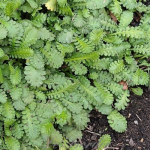
Leptinella dioica is an herbaceous perennial native to New Zealand. It is a creeping and somewhat fleshy plant that bears small and green, fern-like leaves with a touch of bronze. Small, yellow flowers are borne through spring and summer amidst the foliage. It typically grows to 10 cm tall and 70 cm wide, growing best when planted on a well-drained site in full sun or partial shade. This hardy plant has storage roots which enable it to survive moderate frosts, dry periods, and coastal environments. This is a great plant to use as a low groundcover, for planting between rocks and pavers, using in tropical gardens, or planting around pool areas. Can be used as a lawn substitute in low traffic areas which are seasonally damp or somewhat poorly drained. Tolerates sun, wet and dry periods and salt water. Will grow on clay banks. Evergreen. Hardy.
Habitat: Coastal and inland up to 1000 m a.s.l.. In the northern part of its range usually on the margins of saltmarshes but further south extending well inland in seepages and permanently open, damp turfs.
Flowering: Spring - Summer [August - January]
Fruiting: Summer - Autumn [October - June]
Leptinella squalida (Brass Buttons)
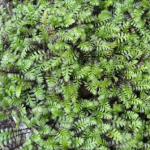
Leptinella squalida, Brass Buttons, is a gray-green creeper with little green leaves that resemble fern fronds. A dense mat-forming perennial, Leptinella squalida turns bronze in autumn. Sometimes called New Zealand Brass Buttons, its tiny yellow button blooms often go unnoticed. It will tolerate moderate foot traffic. Leptinella squalida prefers partial shade to shade and well draining soil.
Habitat: Mostly coastal or inland (0-300 m a.s.l.), in open turf, on coastal cliffs, in coastal turf, along river beds or in open grassland and open, damp places within shrubland and lowland forest.
Flowering: Spring - Summer [August - February]
Fruiting: Summer - Autumn [December - June]
Leptospermum scoparium (Manuka, Tea Tree)
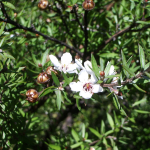
Leptospermum scoparium, the Manuka tree (or Tea Tree), is a fast growing shrub with abundant white flowers in Summer. The flowers are attractive to bees. Both manuka and kanuka are used as a nurse crop with other early colonizing plants for revegetation / restoration planting and are also very effective in erosion control.
Mānuka is often confused with the related species kānuka (Kunzea ericoides) – the easiest way to tell the difference between the two species in the field is to feel their foliage – mānuka leaves are prickly, while kānuka leaves are soft. Alternatively, the seed capsules of mānuka are large (5–7 mm in diameter) and often remain on the plant year round, whereas the seed capsules of kānuka are much smaller (2.2–4.6 mm in diameter) and are not present for much of the year.
History of use: The wood was often used for tool handles. Mānuka sawdust imparts a delicious flavour when used for smoking meats and fish. It is cultivated in Australia and New Zealand for mānuka honey, produced when honeybees gather the nectar from its flowers, and for the pharmaceutical industry. An essential oil, for which many medicinal claims are made, is produced by steam distillation of its leaves.
Habitat: Abundant from coastal situations to low alpine habitats.
Flowering: Spring - Summer [September - March]
Fruiting: Autumn - Summer [Throughout the year]
My Lists: Erosion Control, Wetland, Pioneer Species
Lophomyrtus obcordata (Rōhutu)
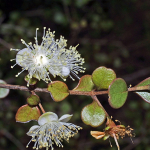
Lophomyrtus obcordata is a bushy shrub with a corded smooth trunk under flakes of bark bearing small thick heart-shaped leaves.
Habitat: Occasionally dominant in alluvial forest remnants of the eastern South Island.
Flowering: Summer [November - March]
Fruiting: Autumn [January - May]
Melicytus alpinus (Porcupine Shrub)
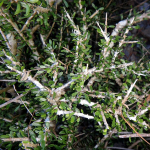
Melicytus alpinus get their common name, porcupine shrub, from the long, almost leafless, spindly branches which resemble the quills of a porcupine. Its leaves are narrow and generally have smooth margins with a few exceptions with serrated edges, however, they do only have a small amount of leaves and they are only approximately 1cm long. Hard and dense, slow-growing in coastal or alpine areas of southern North Island and the South Island it looks almost leafless. But most of the leaves are sheltered between the stiff interlacing stems as an adaptation to the harsh environment where the plant grows. Leaves are variable, leathery.
Melicytus alpinus is very well adapted to extreme weather conditions such as drought, which is why it can be found in areas such as the heavily modified high country of the South Island.
Melicytus alpinus is a habitat to many lizards endemic to New Zealand, this group of lizards include both skinks and geckos. This relationship is mutually beneficial as the lizards use the porcupine shrub as protection from weather and/or predators and in turn eat and spread the seeds from the shrub's berries.
Habitat: Occurs east of the Southern Alps in exposed rocky places between 600m and 1.300m. Found in the wild on very light sand or rocky soils, or on rock outcrops in full sun though it grows on any well-drained soil.
Flowering: Summer [November - January]
Fruiting: Autumn [February - April]
My Lists: Rare Plants
Melicytus crassifolius (Thick-leaved Mahoe)
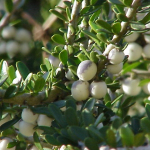
Melicytus crassifolius is heavily-branched, with arching stems that taper at the tips to a sharp point. The small bright olive green leaves are teardrop shaped. It has small, greenish, bell-shaped flowers which appear underneath branches in summer, They form in clusters along the branches. The fruit is small bright white berries and they develop late summer until early winter. Usually, a blue spot appears on the berry with age.
Habitat: This compact hard shrub is endemic to both the North and South Island where it is typically found along coastal lowlands (0-300 m a.s.l.). Usually coastal in open grey scrub, on talus and alluvial terraces, cobble beaches, cliff faces, and in coarse stable sand dunes (especially swales). Inland it may be found in open grassland, amongst kanuka stands and along river flats.
Flowering: Summer [August - January]
Fruiting: Autumn [October - May]
Melicytus ramiflorus (Mahoe, Whiteywood)
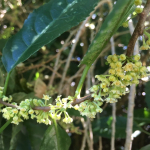 Sold Out
Sold Out
Melicytus ramiflorus, commonly known as Whiteywood or Mahoe, is one of our most common trees, found in forest and shrub throughout New Zealand and growing quickly to 5m or more. The pointed oval leaves are a bright green, with fresh growth being quite soft and an even brighter green. The bark is greyish white and becomes attractively mottled with lichens. Flowers in spring followed by numerous purple black berries. Whiteywood can be clipped for hedging or used as a shelter tree or filler, and will also make quite an attractive specimen. Avoid heavy frosts when young.
The berries of Māhoe are eaten by a number of native birds, including kererū and tui, and some geckos. It is frequently seen in areas of regenerating forest, particularly in areas of disturbed soil. Its early appearance in regenerating forests indicates that it is ideal for revegetation plantings.
Habitat: Abundant small tree of coastal, lowland, and lower montane forests throughout the country.
Flowering: Spring [November - February]
Fruiting: Summer [February - May]
Muehlenbeckia astonii (Pohuehue)
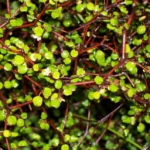
Muehlenbeckia astonii, Pohuehue, is a coastal divaricating shrub with a wiry interlacing habit. Small, bright-green heart-shaped leaves. This plant is extremely hardy, tolerating dry conditions and wind. Popular landscaping plant, providing great contrast. Makes an attractive topiary or hedge. Attracts birds, insects and lizards. Semi-deciduous. Hardy.
Unlike most New Zealand plants M. astonii is leafless in winter. This is when the distinctive branches add interest to the garden. It grows from a distinct trunk and has many fine reddish-brown to orange flexible branches that zigzag around one another to form a dense, interwoven ball. Its flowers, appearing from December to January, are tiny and are greenish to white or pinkish white. The fruits are sweet and edible, eaten by birds and lizards. The plant is an important host for several endemic insect species and in some cases their sole host.
Habitat: Coastal to lowland. This species is associated with “grey” scrub communities, largely confined to drier lowland parts of eastern New Zealand. It is found on moderate to high fertility soils. Its deep root system helps it survive in dry conditions, and can grow on open rocky hillsides and stony ground. It prefers free-draining, warm, sunny slopes, such as the mid-dune areas along the coast. The plant is often found in association with Coprosma crassifolia, Coprosma propinqua, Muehlenbeckia complexa, Discaria toumatou, Olearia solandri and Ozothamnus leptophyllus.
Flowering: Spring - Summer [August - January]
Fruiting: Summer - Autumn [October - April]
Muehlenbeckia axillaris (Creeping Pohuehue)
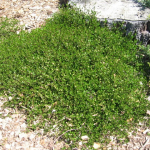 Sold Out
Sold Out
Muehlenbeckia axillaris, commonly known as Creeping Pohuehue or wire vine, is a low dense ground cover, forming wiry mats up to about 1 m in diameter. It spreads along the ground and even underground. It flowers prolifically in summer with masses of small creamy flowers. The flowers are yellowish white, 4-8 mm in diameter, and borne in groups of up to 3 in the axils. Male and female flowers often occur on the same plant and the female flowers form small opaque white fruit. Provides habitat for native copper butterflies. Birds and geckos love the fruit.
This groundcover has stems and small dark green leaves. Muehlenbeckia axillaris has thin wiry red-brown stems, with small dark green leaves that are less than 1 cm in diameter, and 2–4 mm thick. Prefers full sun. Tolerant of hot, dry conditions. Evergreen. Hardy.
Muehlenbeckia axillaris is primarily grown as an ornamental plant for its unique growth habit and attractive foliage. It is often used in rock gardens, coastal gardens, or other landscapes where its trailing habit can be appreciated. It is also used in erosion control and habitat restoration projects due to its ability to stabilize soil and provide cover for wildlife.
Habitat: Found in subalpine rocky places, riverbeds and and grasslands.
Flowering: Summer [November - April]
Fruiting: Autumn [December - April]
My Lists: Erosion Control
Muehlenbeckia complexa (Scrambling Pohuehue)
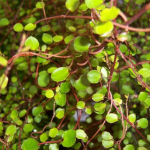 Sold Out
Sold Out
Muehlenbeckia complexa, commonly called scrambling or small-leaved Pohuehue, is quite vigorous and probably the best species for trimming and topiary. It is semi-deciduous, losing most, or all of its leaves over winter. Grows to 4m or more up suitable supports, and produces swollen white berries with black seeds. Leaves turn bronzy before dropping in late fall/early winter. Any reasonably well drained soil will suit this agreeable groundcover, and it'll tolerate drought, salt spray, and wind. Often found growing in the company of Plagianthus divaricatus.
M. complexa can form dense springy mounds, useful for suppressing weeds. In its native environment, it plays a key role in sealing human and natural disturbances on the forest edge. It also suppresses the growth of introduced weeds, such as blackberry, and promotes increased insect diversity. A wide variety of insect species are associated with M. complexa. It is an important host plant for several endemic species of copper butterflies including the coastal copper (Lycaena salustius). It is also a food source for lizards and birds such as tui, bellbird and kererū, which also feed on the buds and leaves.
Habitat: Found along rocky coasts as well as inland in coastal and montane forests.
Flowering: Spring - Autumn [October - February]
Fruiting: Winter [March - June]
My Lists: Erosion Control
Myrsine australis (Mapou, Red Matipo)
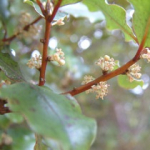 Sold Out
Sold Out
Myrsine australis, or Red Matipo, forms a handsome large shrub or tree with distinctive red branchlets and wavy leaf margins. Similar in appearance to Pittosporum tenuifolium. The cream flowers and later the black fruit are in clusters below the leaves. Used as a specimen, shrub border or hedge.
Habitat: Occurs in lowland forests. Common tree of regenerating and mature forest in coastal to montane situations.
Flowering: Spring - Summer [September - February]
Fruiting: Autumn [February - May]
Myrsine divaricata (Mapou, Weeping Matipo)
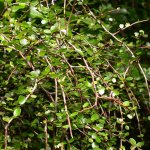
Myrsine divaricata is a small evergreen, bushy shrub, with spreading, drooping branches, which can grow to 6m high. The drooping branches give rise to woody interlacing (divaricating) branchlets bearing solitary leaves or leaves in groups. Tiny flowers, with pale yellow or red petals, occur in clusters. Evergreen.
Habitat: Found in subalpine scrub and forests, preferably where the ground is moist.
Flowering: Winter [June - November]
Fruiting: Spring - Autumn [August - April]
Olearia arborescens (Pekapeka, Common Tree Daisy)
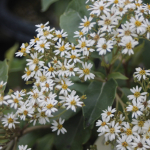
Olearia arborescens is a bushy small tree bearing leathery oval pointed dark green glossy leaves that are paler underneath and large clusters of white daisy-like flowers in Spring to early Summer that develop into fluffy seeds. Leaves variable, 4-8cm long, longer than wide, edge with a few small sharp bumps. The trunk has thin, papery bark which peels in long thin flakes. During spring and summer, it has white flower heads with 15-20 individual flowers (up to 15 mm) on each. Flower petals are white and the centre pale yellow. Hardy, but prefers well-drained or even dry site.
Habitat: Occurs in forest and shrublands in lowland and montane environments. It grows in lowland to alpine scrubland in the North Island from East Cape southwards, and throughout the South and Stewart Islands.
Flowering: Spring - Summer [October - January]
Fruiting: Summer - Autumn [December - March]
Olearia avicenniifolia (Mountain Akeake)
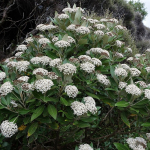
Olearia avicenniifolia, or Mountain Akeake, is an autumn flowering shrub - sweet showy, daisy like flowers. Silver / green large leaf. Very hardy bushy shrub tolerates exposure and dry sites.
Habitat: Occurs in scrub from sea-level to 900m.
Flowering: Autumn [January - April]
Fruiting: Autumn [February - May]
Olearia nummulariifolia (Tree Daisy)
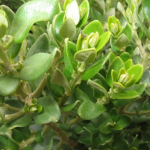
Olearia nummulariifolia is a medium-sized, much-branched, box-like shrub. It's stiff branches give the bush an unusual appearance. Olearia nummulariifolia has small closely set yellow-green leaves (5-10mm long and 4 -6 mm wide). They are leathery, very thick and small roundish (coin-shaped hence the specific name) leaves that have a brownish tomentum underneath.. Its daisy flowers appear in spring through to autumn on the branch tips. Ideal for low hedging.
Habitat: It is found in alpine dry and open situations usually at 600–1,400 m, from Lat 37 degrees 30 minutes southwards throughout New Zealand descending to lowlands in the southern part of its range.
Flowering: Summer [November - April]
Fruiting:
Olearia paniculata (Akiraho, Golden Akeake)
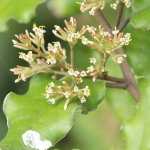
Olearia paniculata, Akiraho, is a rounded small tree with yellowish-green wavy leaves. Flowers small, white, in dense clusters. Fragrant sweet-scented flowers are borne in autumn. A good shelter plant. Hardy and tolerant of coastal conditions.
Due to its attractive appearance and hardiness, Olearia paniculata is sometimes cultivated as an ornamental shrub in gardens and landscapes. It can be utilized as a hedge, specimen plant, or included in mixed border plantings.
Habitat: Found in scrub east of East Cape to south Canterbury
Flowering: Autumn [March - May]
Fruiting: Winter [April - July]
Ozothamnus leptophyllus (Tauhinu, Cottonwood)
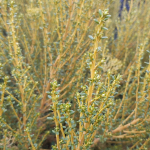
Ozothamnus leptophyllus, commonly called Tauhinu or Cottonwood, is a bushy shrub with small yellow green leaves. It has an attractive golden appearance and flowers in profusion with clusters of tiny cream daisy (wheel-shaped) flowers followed by down-covered seed heads. It is fast-growing, reaching its maximum height of 2 metres in 10–15 years.
Tauhinu can readily colonise bare hillsides and pasture, with seeds readily dispersed by the wind. It grows rapidly, acting as a nursery plant for other species. Unless their under storey plants are heavily grazed, Tauhinu shrublands are usually overtopped by taller shrubs and trees. Because of this, Tauhinu makes an excellent coastal or dry woodland revegetation plant. It prefers a sunny location and is frost hardy.
Habitat: Found in coastal to subalpine shrubland.
Flowering: Summer [December - March]
Fruiting: Autumn [March - April]
My Lists: Pioneer Species
Phormium cookianum (Wharariki, Mountain Flax)
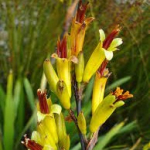
Phormium cookianum, Wharariki, is commonly called Mountain Flax, is a superb species, one of the hardiest and the most striking. Long arching green leaves all year round, and 2 metre long flower stalks over summer - particularly attractive to native birds. Use as a 'groundbreaker' in new gardens, en masse on banks. Foliage and flowers are great for floral artwork.
Phormium cookianum is a flax up to 1-3 metres tall but generally smaller than Phormium tenax. The numerous leaves are 5-12cm wide, thick, fibrous, droopy, and rise from fan-like bases. The tubular 25-40 mm long flowers are a dull pink or yellow colour. The seed capsule is pendulous and twisted.
Habitat: Strictly confined to subalpine, alpine situations, where it mainly grows on cliffs and mountain slopes, in seepages, along stream sides or on the margins of bogs.
Flowering: Spring [November - December]
Fruiting: Summer [January - March]
Phormium tenax (Harakeke, Swamp Flax)
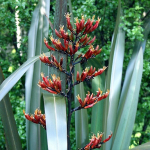
Phormium tenax, Harakeke, commonly called Swamp Flax, is one of the oldest plant species in New Zealand and it is unique to New Zealand. With its sword-shaped leaves it is a common feature of the New Zealand landscape. It grows up to 2 -3 metres high and its flower stalks can reach up to 4 metres. The flowers are brownish red in Summer, followed by black seed pods that stand upright from the stems. It is very hardy and fast growing with wide environmental tolerances. It will grow in dry and wet conditions, withstand strong and coastal winds and are frost hardy. It is used for hedging or shelter and in mixed native planting. It is also a pioneer plant meaning it should be one of the species planted first in a restoration planting plan as it establishes quickly when planted and shelters other plants.
Plant communities that include Apodasmia similis, Carex maorica, Carex secta, Carex virgata, and Eleocharis acuta often contain Phormium tenax.
History of use: Traditional uses of flax No fibre plant was more important to Maori than flax. Each pa or marae typically had a pa harakeke or flax plantation. Different varieties were specially grown for their strength, softness, colour and fibre content. Traditionally when harakeke leaves were removed from the plant, only the older leaves on the outside were taken. It is believed the three inner layers of the plant represented a family. This outer layer represented the grandparents, whereas the inner layer of new shoots or the child remained to be protected by the next inner layer of leaves, the parents. The uses of the flax fibre were numerous and varied. Clothing, mats, plates to eat off, baskets, ropes, bird snares, lashings, fishing lines and nets were all made from flax. Babies were even given rattles made from flax. Other parts of the plant were also used. Floats or rafts were made out of bundles of dried flower stalks (kokari). The abundant nectar from flax flowers was used to sweeten food and beverages. Flax also had many medicinal uses. The sticky sap or gum that flax produces was applied to boils and wounds and used for toothache. Flax leaves were used in binding broken bones and matted leaves were used as dressings. Flax root juice was routinely applied to wounds as a disinfectant. Today, flax is used in soaps, hand crèmes, shampoos and a range of other cosmetics. Flax seed oil can also be found for sale.
Habitat: Common from lowland and coastal areas to montane forest, usually but not exclusively, in wetlands and in open ground along riversides.
Flowering: Summer [November - December]
Fruiting: Summer [January - April]
My Lists: Erosion Control, Wetland, Pioneer Species
Pimelea declivis
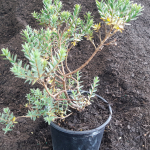
Pimelea declivis is a small blue-green erect shrub native to Canterbury. Inhabiting limestone outcrops from south Marlborough to south Canterbury.
Habitat: Lowland to lower montane, Mostly found in sparse grassland and grey scrub associated with limestone ridges, scarps, cliffs, outcrops, screes and boulder heaps.
Flowering: Spring - Summer [October - May]
Fruiting: Summer - Autumn [November - May]
My Lists: Rare Plants
Pimelea prostrata (Pinatoro, NZ Daphne)
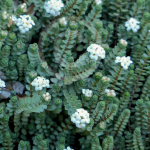
Pimelea prostrata, Pinatoro, or NZ Daphne, is a native groundcover with an attractive low growing plant with white flowers. It flowers prolifically over the summer months and is followed by small clear, white berries. The outstanding blue green foliage is a stand out with this groundcover. Is best grown in a free-draining soil in a full sun position. Excellent for sunny banks or rockeries.
Habitat: Coastal to montane. In open sites, such as coastal gravel, sand dunes, grasslands and mudstone cliffs.
Flowering: Spring - Autumn [September - May]
Fruiting: Winter [October - July]
Pittosporum eugenioides (Tarata, Lemonwood)
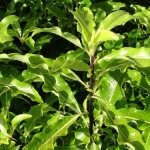
Pittosporum eugenioides, Tarata, commonly called Lemonwood, is a bushy tree ideal as a specimen or for hedging. Lemon scented foliage and fragrant flowers (spring).
Great in a windy position and also provides a barrier for the surrounding more intolerant plants. Pittosporums can be excellent stand-alone features, hedges, screens, windbreaks, shrubberies or topiary specimens. The highly ornamental, evergreen foliage almost always looks well-groomed and responds well to pruning. Frost tender when very young. Prefers a sunny to part shade position, does not mind the wind, and thrives in soil with good drainage. Tarata is somewhat drought-resistant therefore rainfall is not a major factor in its survival.
It has proved to be a great plant for establishing a quick canopy in a restoration project. It then provides an opportunity to introduce understory, shade loving plants to the same location, later planting underneath the lemonwood trees. Lemonwood is on the recommended list for replanting “small trees up to 6m.”
History of use: Maori used the gum from the bark in complex scent formula along with parts of other plants.
Habitat: Common tree of regenerating and mature forest in coastal to montane situations. It is found in forest clearings and along forest margins up to 600m above sea level.
Flowering: Spring [October - December]
Fruiting: Autumn [March - June]
My Lists: Erosion Control
Pittosporum tenuifolium (Kohuhu, Black Matipo)
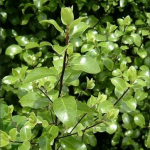
Pittosporum tenuifolium, Kohuhu, commonly called Black Matipo, is endemic and widespread throughout New Zealand. It is an extremely popular, adaptable and fast growing. Shiny light-green foliage with wavy margins and reddish brown branchlets. Fragrant dark red flowers in spring. Excellent plant for hedging and shelter. Tolerates wind, drought, frost, coastal conditions. A key species for forest revegetation and also a useful riparian edge plant. Kōhūhū grows particularly quickly at forest edges located at the bottom of high terraces. Sun or shade. Hardy. Evergreen.
The flowers’ colour ranges from dark-red to dark-purple turning almost black as the flowers age. Nectar fills the flowers. The flowers exude a honey-scented fragrance in the evenings with the scent being more obvious in slightly damp conditions. This attracts moths and night-flying insects, New Zealand’s indigenous pollinators. Fertilised flowers develop into small fruits that blacken as they ripen.
Habitat: A small tree of coastal to montane shrubland and forested habitats. Preferring successional habitats.
Flowering: Spring - Summer [October - January]
Fruiting: Autumn [February - June]
My Lists: Erosion Control
Poa cita (Wi, Silver Tussock)
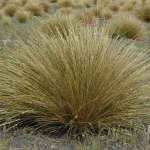
Poa cita, Wi, or Silver Tussock, is a densely tufted tussock of a graceful habit. Fine shiny silvery-green erect foliage with a flowing habit. Slender flowering stem, tawny coloured. Best in poor dry soils in an open situation. Excellent for mass planting. Great for exposed windy sites.
Habitat: Preferring a full sun position, tolerant of light shade, coastal conditions, and drought. Poa cita is often found in dry woodland and grassland plant communities
Flowering: Summer [November - December]
Fruiting: Summer [January - February]
My Lists: Pioneer Species
Podocarpus nivalis (Snow Totara)
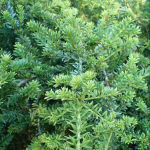
Podocarpus nivalis, commonly called Snow Totara, is a low growing, almost prostrate shrub found in sub alpine parts of New Zealand, although can grow at low altitude as well. It has small leathery olive-green leaves and edible red berries in the autumn. Fantastic option for a trimmed low hedge.
Habitat: Montane to alpine. Common in open tussock grassland and subalpine scrub.
Flowering: Spring [September - November]
Fruiting: Autumn [December - June]
Podocarpus totara (Totara)
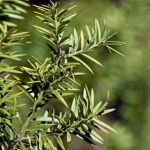
Podocarpus totara, is a classic NZ Native with needle like leaves, olive green, orange-red fruit. Bark red / brown, good shaped tree with durable timber. Tolerates wide range of sites. Evergreen. Frost tender when young.
Commonly known as Totara, trees are either male or female with the female trees having bright red, berry-like fruit in autumn. Male trees do not bear fruit. It grows with a broad and spreading habit to eventually reach 20 m tall and 10 m wide, and can be included in a medium sized garden due to its slow growth rate. Best results with this tree are achieved when it is grown in full sun on a well-drained site. It is tolerant of mild drought, frost, cool climates, some wind, and coastal environments. Totara is commonly included in a mixed planting in a large garden, used in native plantings, or grown as a specimen.
Habitat: Widespread and at times abundant tree of lowland, montane and lower subalpine forest. May also form a vegetation type in which it is the dominant species.
Flowering: Spring [October]
Fruiting: Autumn [March - May]
Pseudopanax arboreus (Whauwhaupaku, Fivefinger)
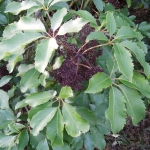
Pseudopanax arboreus, commonly called Fivefinger, is one of New Zealand's most common native trees found from Cape Reinga to Bluff in lowland forests. Its particular form of a glossy, five to seven fingered leaf along with quick and luxuriant growth. It grows into a small stout tree up to 5 metres high and grows well in most soils and situations. Fast growing with small purplish black berries in autumn.
History of use: New Zealand Beekeepers Magazine rates Pseudopanax arboreus as a star performer for food for bees. The trees provide abundant pollen and copious, rich nectar very early in the season when few other species are in flower (from June to August). Plant in good numbers clustered together to amplify the availability of flowers for bee feed. Bees love the small scented green flowers that are followed by bunches of dark purple fruits enjoyed by birds from August to February. Flower buds can be easily mistaken for ripe fruit whereas clusters of fruit are actually ripe one year after flowering.
Habitat: Coastal to montane. Moist broadleaf forest. Frequently epiphytic. A frequent component of secondary forest and forest margins. Tolerant of moderate frosts and coastal conditions but should be sheltered from strong winds.
Flowering: Winter [June - August]
Fruiting: Spring - Summer [August - February]
My Lists: Winter Pollen
Pseudopanax crassifolius (Horoeka, Lancewood)
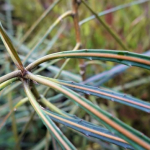
Pseudopanax crassifolius, commonly known as Lancewood or Horoeka, is a species of evergreen tree that is native to New Zealand. It belongs to the family Araliaceae and is known for its unique growth habit and distinctive foliage.
Lancewood typically grows to a height of 3 to 10 meters, though it can reach up to 15 meters in favorable conditions. It has a slender, erect trunk that is often unbranched for several meters, giving it a distinctive lance-like appearance. The trunk is smooth and grayish-brown in color, and it is often marked with vertical ridges or scars from fallen leaves.
The leaves of Pseudopanax crassifolius are leathery and glossy, with a lanceolate shape that tapers to a point. They are typically dark green in color and can measure up to 60 centimeters in length. The margins of the leaves are serrated or toothed, which adds to their distinctive appearance.
One of the most striking features of Pseudopanax crassifolius is its ability to change its leaf shape as it matures. Young Lancewood trees have long, narrow leaves with serrated margins, while older trees develop larger, broader leaves with smooth margins. This unique leaf morphology has earned it the nickname "lancewood" due to its resemblance to a lance or spear.
Pseudopanax crassifolius produces small, inconspicuous flowers that are typically green or cream-colored. The flowers are arranged in clusters and are followed by small, fleshy fruit that ripens to a dark purple or black color. The fruit is an important food source for native birds in New Zealand.
Lancewood is a hardy plant that is well-adapted to New Zealand's coastal and lowland forests. It can tolerate a wide range of soil types, but prefers well-drained soils. It is a slow-growing species and can take many years to reach maturity.
In addition to its unique appearance, Pseudopanax crassifolius has cultural significance for the Māori people of New Zealand, who have traditionally used its wood for various purposes, including weapons, tools, and construction. Today, it is also a popular ornamental plant in gardens and landscapes, prized for its distinctive foliage and architectural form.
Habitat: Lowland to montane forest. Sealevel to 750 m
Flowering: Summer - Autumn [January - April]
Fruiting: Autumn [January - April]
My Lists: Pioneer Species
Pseudopanax ferox (Horoeka, Toothed Lancewood)
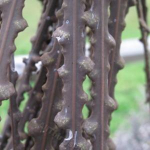
Pseudopanax ferox, Toothed or Fierce Lancewood, is a spectacular slow-growing specimen with narrow, down pointing saw-like brown very tough juvenile leaves that have irregular blunt bumps along the edge. Once the slow-growing tree reaches maturity at 10 to 15 years, the leaf form becomes shorter, wider and dark green in colour. It is only in adulthood that the tree's shape changes from one central stem and has downward growing leaves to a more typical tree shape with branches spreading to build a round head. A mature toothed lancewood can reach 6 metres height with a trunk of up to 25 cm in diameter.
Habitat: Coastal to subalpine (10-800 m a.s.l.) on consolidated sand dunes (dune forest), in grey scrub overlying pumice, on recent alluvial (coarse gravels), limestone outcrops, boulder fall, cliff faces, talus slopes and scarps. Also found as a sparse component of seasonally drought-prone but otherwise cold and wet alluvial forests. This species prefers drier habitats and conditions than P. crassifolius.
Flowering: Summer [November - April]
Fruiting: Autumn [December - June]
Pseudowintera colorata (Horopito, Pepper Tree)
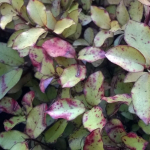 Sold Out
Sold Out
Pseudowintera colorata is endemic and found throughout the country in coastal to montane areas. It is often found in heavily browsed forests and therefore not threatened. Unpalatable to browsers due to its peppery leaves. Pseudowintera colorata is evergreen and likes moist soil rich in organic matter.
Habitat: Coastal, lowland, or montane forest margins and shrubland.
Flowering: Summer [November - March]
Fruiting: Autumn [December - June]
Sophora microphylla (South Island Kowhai)
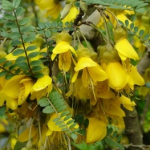
Sophora microphylla is also known as South Island Kōwhai, having showy yellow flowers in early spring. This particular Kōwhai has very small leaves (microphylla) and a tangled juvenile form, tending to straighten up and grow from an upright trunk at about four years. Kōwhai makes a good garden tree and is necessary for revegetation projects as a bird attractor. Kōwhai are suited to upper bank plantings of riparian areas. They also make beautiful shade or specimen trees. Semi-deciduous. Hardy.
Sophora microphylla have horn-shaped yellow flowers. The nectar is a favourite food for Tui, Bellbird and Kererū which also eat the leaves. The seed pods which appear after flowering stay hanging on the tree through winter.
Kōwhai is the national flower of New Zealand.
Habitat: In the North Island, especially the northern half this is a species of mainly riparian forest. South of Hamilton it can be found in a diverse range of habitats from coastal cliff faces and associated wetlands to inland grey scrub communities. Sophora microphylla and Sophora prostrata are the only forms naturally existing in Canterbury.
Flowering: Winter [August - October]
Fruiting: Spring - Summer [October - May]
My Lists: Winter Pollen
Sophora prostrata (Dwarf Kowhai)
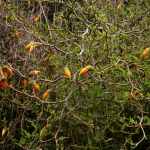 Sold Out
Sold Out
Sophora prostrata, commonly known as Dwarf Kowhai, is a low-growing shrub or small tree species that belongs to the family Fabaceae. It is native to New Zealand and is known for its vibrant yellow flowers and unique, prostrate growth habit.
One of the most distinctive features of Sophora prostrata is its striking yellow flowers, which are pea-like in shape and arranged in clusters at the ends of the branches. The flowers usually appear in late winter or early spring, and their bright yellow color is a standout feature against the dark green foliage. The flowers are attractive to bees and other pollinators.
Sophora prostrata is endemic to New Zealand, where it is found in a variety of habitats including coastal cliffs, sand dunes, shrublands, and forests. It is particularly well-adapted to tolerate salt spray and harsh coastal conditions, which makes it suitable for coastal gardens and landscaping.
Sophora prostrata serves as an important host plant for the caterpillars of several native butterfly species. Additionally, Sophora prostrata is a popular ornamental plant in gardens and landscapes due to its attractive flowers and unique growth habit. Semi-deciduous. Very tough on exposed, cold, dry sites.
Habitat: Found from the coast to subalpine in open rocky planes. Confined to the eastern South Island from Marlborough to the Waitaki Valley.
Flowering: Spring [September - October]
Fruiting: Summer [January - February]
Veronica salicifolia (Koromiko, Hebe salicifolia)
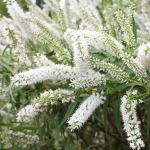
Veronica salicifolia, Koromiko, formerly called Hebe salicifolia, is a fast-growing large, spreading shrub. Provides good low shelter and is an excellent revegetation plant. It has showy white to pale lilac drooping flowers and willow-like foliage. Prefers a moist soil. Trim after flowering in a garden setting.
Veronica salicifolia is a hardy plant but isn’t tolerant of shade and needs to be grown in full sun and in a sheltered area with well-drained soil. It can, however, tolerate wet areas and can often be found on the edge of bush and wetlands. Once established they have considerable drought and frost tolerance.
History of use: The Māori utilized the plant’s medicinal properties for centuries. The leaves were chewed to help cure diarrhoea and applied to the skin to aid ulcers and wounds. Koromiko is the general name for the Hebes in Te Reo and is shared over a range of New Zealand Veronica species.
Habitat: Occurs from sea-level to close to the treeline, mostly in open sites, and forest margins. Is used in lower bank riparian edges where their roots can dry between rain events, but the soil stays damp.
Flowering: Summer [December - May]
Fruiting: Autumn [January - June]
My Lists: Pioneer Species
Veronica traversii (Hebe traversii)
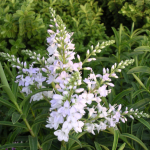
Veronica traversii, formerly known as Hebe traversii, is an erect bushy shrub with green branchlets. Oblong narrow dull mid green leaves, dull green underneath. The white flowers with red stamans, are long and loose making a great show in spring over a long period. It will grow in sun or semi-shade, best in well drained soil, will grow in dry sites. Hardy to cold. A very tidy plant that clips well, and stays looking great for many years.
Habitat: Grows in scrub and at forest margins, often in river valleys, in situations ranging from near-coastal to montane or subalpine.
Flowering: Summer [January - February]
Fruiting:
